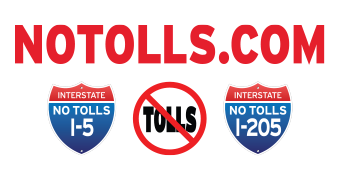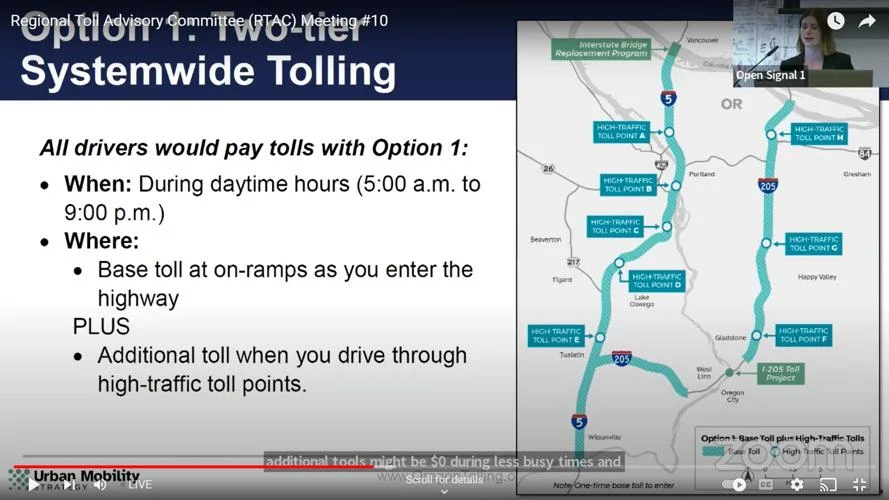ODOT pushing ahead with tolls for I-205 and I-5
By Holly Bartholomew Sep 18, 2023 Portland Tribune
Though Gov. Tina Kotek has put tolling on pause until 2026, the Oregon Department of Transportation is still moving forward with two projects (and a third in partnership with the state of Washington for the Interstate Bridge) that will bring tolling to the Portland metro region within the next five years.
Prompted by consistent pushback from residents and local elected officials in Clackamas County — where much of the tolling would take place — Kotek earlier this year asked ODOT to hold off on tolling on I-5 and I-205 until more thorough analysis of its impacts on nearby communities was completed.
ODOT had previously planned to implement tolls on I-205 at the Tualatin River Bridge and Abernethy Bridge as early as 2024 as part of the I-205 toll project. The agency still expects to toll the Abernethy Bridge under that project to pay for reconstruction of the bridge, which is currently underway.
Retrofitting of Abernethy to withstand a major earthquake was originally part of the I-205 improvement project, which ODOT recently decided to scale back. But due to a shortfall in funding, ODOT has scrapped plans that have been in place for several years to add a third lane of traffic to a seven-mile stretch of I-205 between Tualatin, West Linn and Oregon City.
Leaders react to latest plans
During a Sept. 18 discussion of both the I-205 toll project and the separate Regional Mobility Pricing Project at a Regional Tolling Advisory Committee meeting, Clackamas County Commissioner Paul Savas expressed concern over ODOT nixing the third lane on I-205.
“We got behind the I-205 project well over a decade ago because of the diversion that we experience today as a result of the bottleneck (on I-205 between the Tualatin River and Abernethy Bridge, where a third lane was planned to be built). Tolling now compounds that,” Savas said. “What we learned from the last RTAC meeting or shortly after the OTC meeting was ODOT won’t complete the bottleneck on I-205, that they canceled that project, which means we’ll have all of the diversion we have today plus the additional diversion of those people avoiding the toll. That’s the worst case scenario we could ever fathom and that’s where we are today.”
In addition to the I-205 toll project, the committee discussed the Regional Mobility Pricing Project — ODOT’s plan for tolling all or most of I-5 and I-205 between the Columbia River and the Boone Bridge in Wilsonville.
The main objectives of that project are to reduce congestion and raise revenue for other transportation projects.
ODOT officials and consultants presented the committee with two options for the Regional Mobility Pricing Project: a “system-wide” toll for all of I-5 and I-205 in the metro region and “toll zones” which would see most of those corridors tolled via separate tolling sections.
How the options work
Both options would involve tolling all lanes of both interstate corridors during the day. There would be no tolls overnight after 9 p.m. These options also include higher tolls during peak traffic times and a set toll schedule so drivers should know the amount they’d pay before the trip.
Under option 1, the systemwide tolling plan, drivers would pay tolls between 5 a.m. and 9 p.m. Drivers would pay a base toll when entering the freeway via on-ramps, and possibly more tolls at “high-traffic toll points” along the interstate. Option 1 is proposed to have five high-traffic toll points on I-5 and three on I-205.
Under option 2, drivers would pay one toll for each toll zone they drive through. There would be four toll zones on I-5 and three or four on I-205. Tolls could be $0 during low-traffic periods.
ODOT expects option 1 would take two to four years to put in place, whereas option 2 could be implemented quicker.
Mandy Putney of ODOT’s Urban Mobility Office said that based on ODOT’s initial projections, it would cost drivers $5-6 to drive from one end of the toll area to the other under either option. She added that traveling less than seven miles through the corridor would likely cost less than $2.
Next steps
The agency is in the midst of the federally-mandated environmental assessment for the Regional Mobility Pricing Project, which should be published for review and comments in 2024.
Putney said a survey would go out to the public regarding the options on Sept. 26.
During the meeting, West Linn Mayor Rory Bialostosky questioned Oregonians’ appetites to pay to drive on the freeways they already use for free.
“I’m struck by how big a change this will be for the people of Oregon,” Bialostosky said. “The Metro region has never seen something like this, so I’m concerned about that and how people will react to this proposal.”
Bialostosky also questioned ODOT’s projections showing the Regional Mobility Pricing Project would result in a marginal difference in diversionary traffic on local roads. Putney acknowledged that those projections were based on a “macro view” of the region and further analysis of diversion on a more localized level would take place during a later planning phase.
Though the Regional Mobility Pricing Project is not at the same stage as the I-205 toll project, ODOT hopes they could launch around the same time in 2026.
The committee also heard from TriMet’s policy and planning director Tom Mills, who emphasized that the transit provider is now examining how new projects could complement the tolling plans when deciding how to allocate funds.


